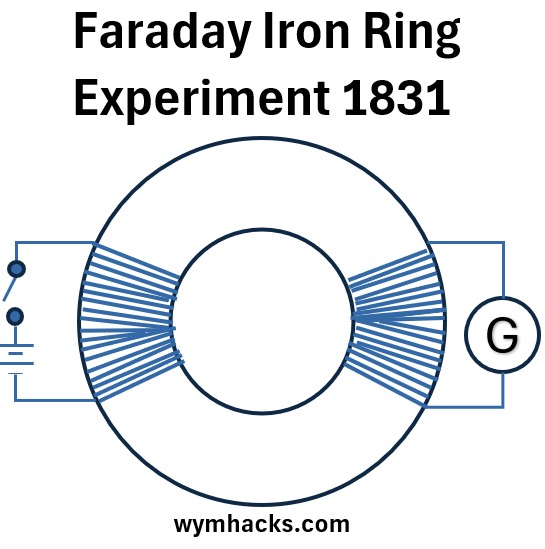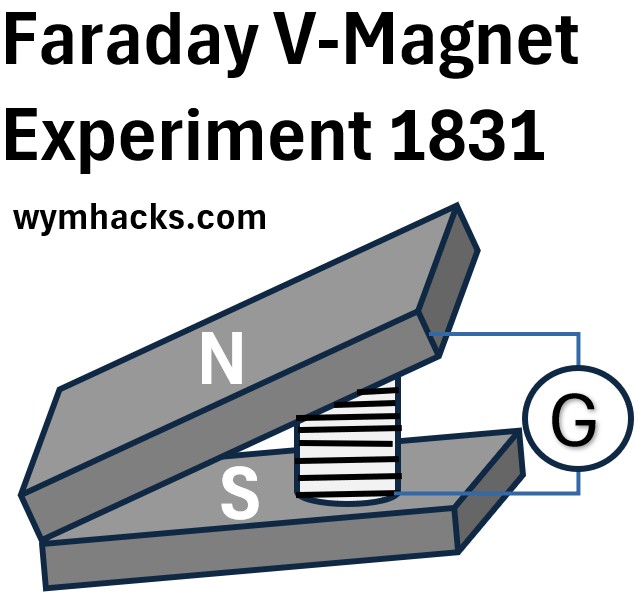Menu (linked Index)
Faraday’s 1831 Electromagnetic Experiments
Last Update: September 14, 2025
Introduction
We know today that a changing magnetic field can induce an electric current.
Michael Faraday, in a series of experiments in 1831, discovered this phenomenon of Electromagnetic Induction.
Electromagnetic Induction occurs when
-
a changing magnetic field (due to a magnet or coil moving or magnetic field strength changing)
-
produces an electric current (due to a created electromotive force, EMF) in a conductor.
This means that if a conductor moves through a magnetic field, or if the magnetic field around a conductor changes, an electric current will be induced in the conductor, provided it’s part of a closed circuit.
This principle is fundamental to how generators, transformers, and many other electrical devices work.
In this post, we’ll review these famous experiments.
If you want to read a really good book on Michael Faraday and his experiments (or really on electromagnetism in general), then read this one:
- Faraday, Maxwell, and the Electromagnetic Field by Nancy Forbes and Basic Mahon; 2019; By Prometheus Books
You can also review these nice electromagnetic Induction Videos:
Iron Ring Experiment
In the Iron Ring Experiment,
- Faraday wound two separate coils of insulated wire around opposite sides of a soft iron ring.
- One coil (the primary coil) was connected to a battery with a switch.
- The other coil (the secondary coil) was connected to a galvanometer, a device used to detect electric current.
Picture: Faraday Iron Ring Experiment 1831

Closing the primary circuit switch:
- A current flowed through the primary coil.
- This current created a magnetic field in the iron ring.
- As the magnetic field built up in the iron ring, the galvanometer showed a momentary deflection,
- indicating that a current was briefly induced in the secondary coil i.e.
- a steady magnetic field does not induce a current.
Opening the switch:
- Current and magnetic field in ring go to zero.
- The galvanometer again showed a momentary deflection, but this time in the opposite direction,
- indicating a current induced in the opposite direction.
Faraday’s iron ring experiment demonstrated that it wasn’t the presence of a magnetic field itself that induced a current, but rather the change in the magnetic field.
V-Magnet Experiment
Picture: Faraday V-Magnet Experiment 1831

In the V-magnet Experiment,
- Faraday put a wound coil between two magnets as shown in the picture above.
- As soon as the ends of the magnets were connected, the Galvanometer flicked.
- Pulling the magnet ends apart, caused another flick in the opposite direction
In this experiment, Faraday showed that electricity was directly produced by magnets.
Magnet and Coil Experiment
Picture: Faraday Magnet and Coil Experiment 1831

In Faraday’s Magnet and Coil Experiment,
- A coil with many turns is connected to a Galvanometer.
- Taking an ordinary magnet and moving it into and out of the coil,
- the Galvanometer needle swung vigorously one way and then the other.
This is the third of the three famous Faraday experiments showing that a changing magnetic field can induce an electric current in a nearby conductor.
This phenomenon is called electromagnetic induction and it established a fundamental link between electricity and magnetism.
Disclaimer: The content of this article is intended for general informational and recreational purposes only and is not a substitute for professional “advice”. We are not responsible for your decisions and actions. Refer to our Disclaimer Page.
